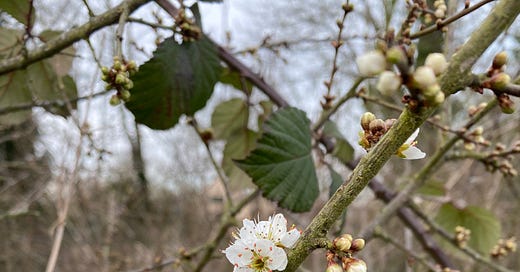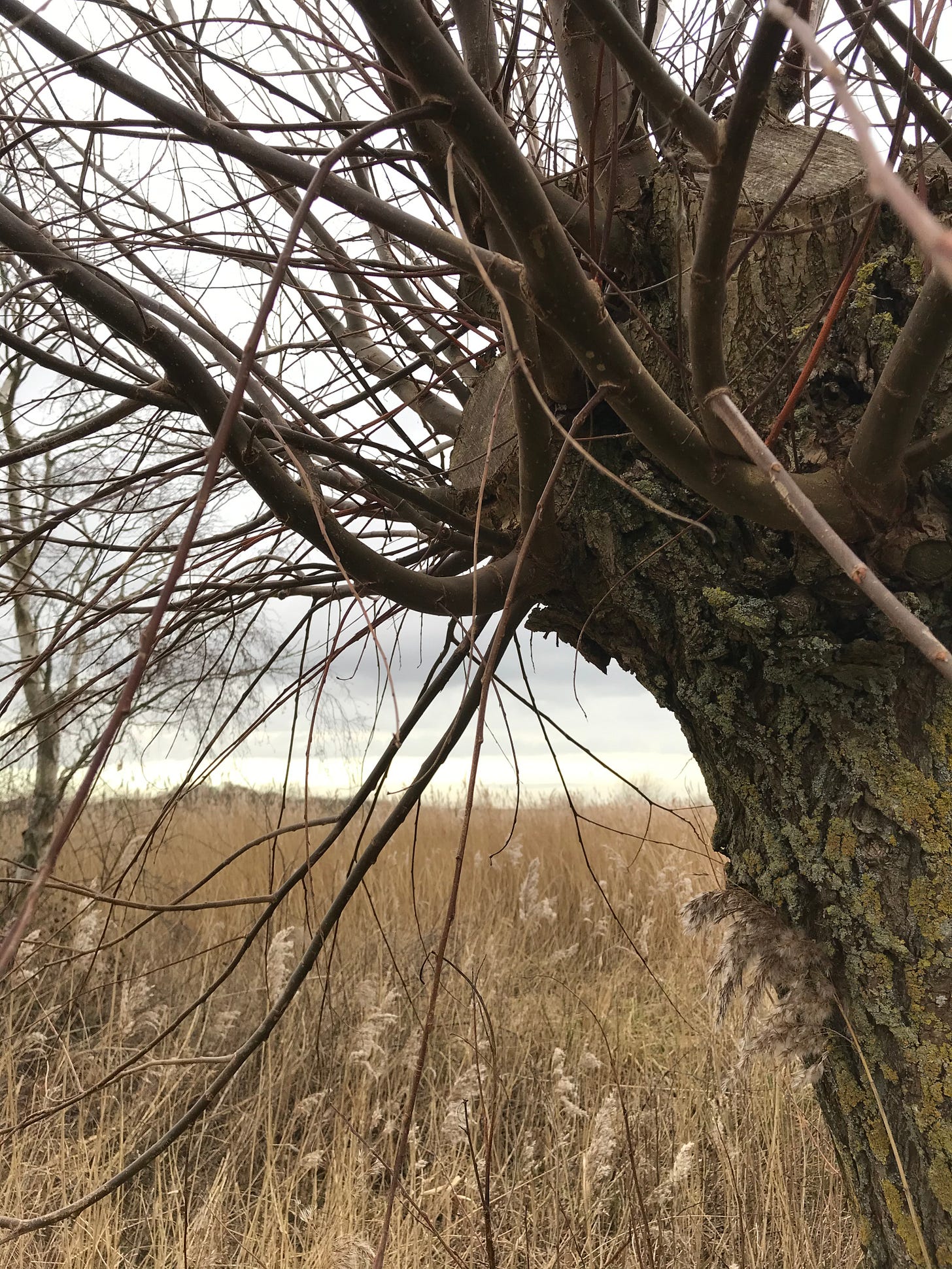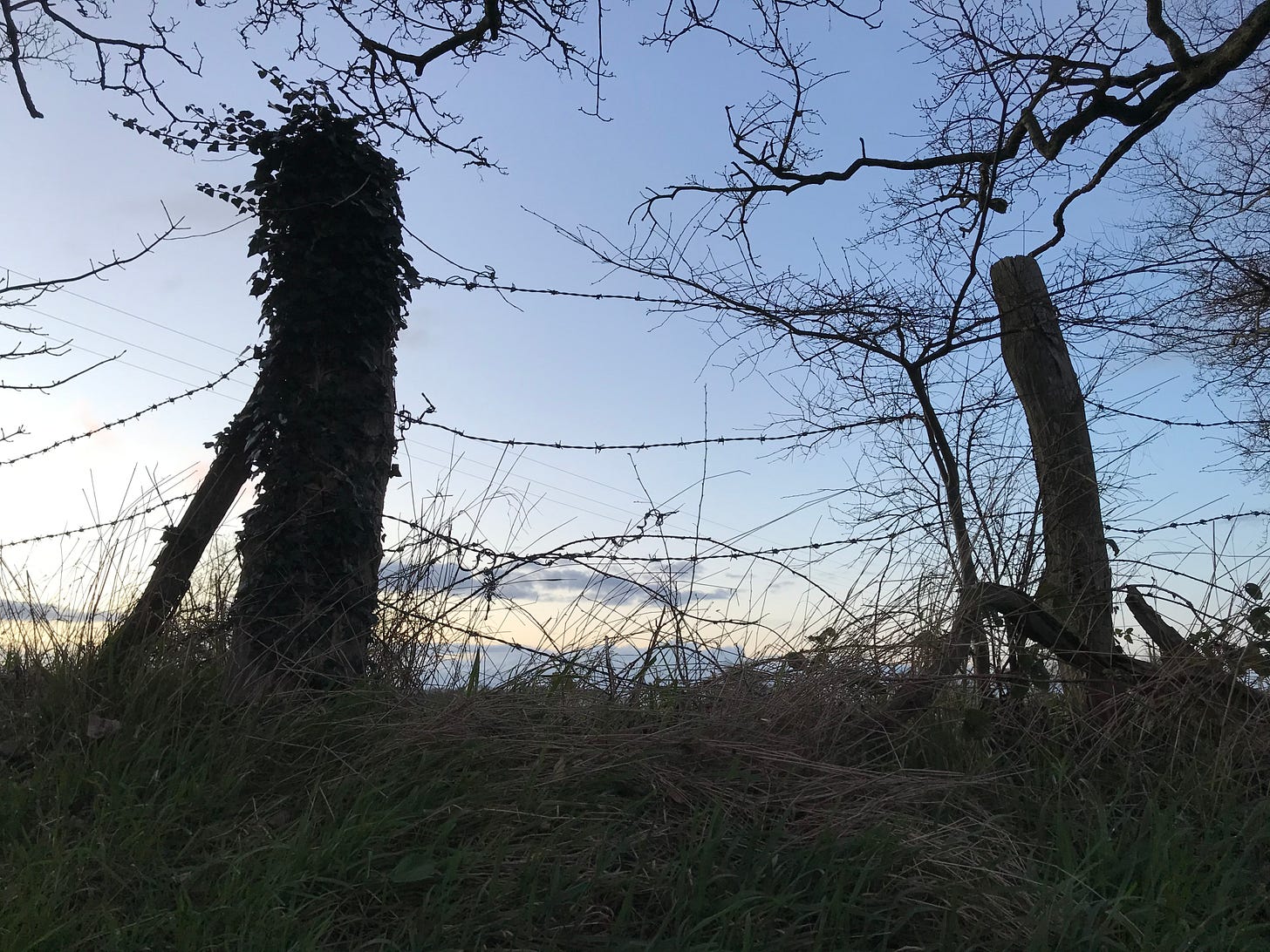March blackthorn flowers along the lane.
This is what I know about blackthorn.
How bravely it flowers
on naked twigs, on swept grey days
as March winds shake the glitter from its spines;
how it foams in the hedgerows:
cold starry blooms
with gold eyes, watching
for something winged to alight,
for some glimpse of spring.
And how it has a reputation
for strife; how fierce it is
in the gap, such a strong defender
brandishing its spears.
Its wood is good for cudgels.
How it is called in France
‘Mother of the Wood’ -
but a wild mother
dark-clawed as any fox
whose milk nourishes sloes
that make your tongue pucker …
Hilary Llewellyn-Williams, from Comfort in Blackthorn
What’s in a Moon Name?
And so we come today to the March full moon, which this year falls early in the month. Here, March has come in more like a Lion than a Lamb. Today I was pounded by hail! How is it where you are?
Although many Native American tribes - and of course the peoples of many other cultures - gave distinct names to each full moon, it’s the Algonquin versions that are best known. This is probably because the Algonquin had the greatest influence on the early European settlers. As each name was applied to the entire lunar month in which it occurred, these cycles helped the tribe to keep track of the seasons. The settlers must have seen the brilliance of this idea, even being inspired to invent some names of their own which have been passed down through time.
If you Google the March full moon, you will nearly always see it listed as the Worm Moon. For the Algonquin tribes the worm was a powerful harbinger of the spring. Snow began to melt, the ground softened, earthworms showed their heads again and their nutritious fertilising casts began to be in evidence. While no-one quite knows why the worm was chosen above other symbols, it’s been suggested worm trails appearing in the newly thawed ground would invite robins and other birds to feed, and that their presence was the real sign of the season.
Another theory relates to Captain Jonathan Carver who visited Native American tribes in the 1760s. He wrote that the name Worm Moon actually refers to the beetle larvae that emerge from the thawing bark of trees and other overwintering habitats at this time.
Other signs of spring gave rise to different names. The cawing of crows suggested Crow Moon, the effect on the snow of repeated freezing and thawing was remembered in Crust Moon, and the time for tapping maple trees, in Sap Moon. Christian settlers also called this the Lenten Moon and considered it the last moon of winter.
In fact, it’s the Anglo-Saxons who first called the last full moon before the spring equinox the Lenten Moon. The word ‘Lenten’ originates in the Germanic languages and denotes springtime or ‘lengthening of the day’, rather than having any direct link with the Christian tradition. But if March’s full moon happens after the spring equinox it becomes the Paschal Moon instead, which means ‘of or relating to Easter’.
As ever, other options are available and for March I’ve found a veritable banquet for you. There’s the Goose Moon (Algonquin, Cree), Sugar Moon (Ojibwe), Wind Strong Moon (Pueblo), Sore Eyes Moon (Dakota, Lakota, Assiniboine, referring to blinding sunlight reflecting off snow), Melting Moon (Nipmuck, Algonquin), Warming Moon (Shoshone), Wind Moon and Plough Moon (Celtic), Death Moon (more recent neopagan, referring to the death of winter), Chaste Moon (Old English, referring to the purity of spring), Windy Moon (Cherokee) and Sleepy Moon (Chinese). In his ‘Liber Nox’ (Troy Books 2014) Michael Howard lists the March Moon as belonging to Hare, which I rather like.
How about you? Will it be Hare Moon for you, or is there some other symbol of this tricksy month of promise that calls to you more strongly where you live? Bearing in mind that a moon name is for a whole lunation, not just for the perfect moment when the sphere has blossomed to full, is there a word or words that capture that for you?
One way of finding your own name is to go for a walk and consciously engage all your senses with each step. At the same time it’s good to empty your mind so that memories can trickle in too. If you’re still not sure when you arrive home, maybe make a shortlist of five words/phrases and then look at those and see what jumps out like a mad March hare!
As for my own choice it may have to be Otter Moon, as my first magical otter sighting at the stream took place in March last year, never to be forgotten. Wild Garlic Moon is another possibility as the very air is filled with its scent at the moment.
The alder carr on 7 March 2021. The ripples and reflections turned it into an enchanted world.
March Amulet
Ash wand of immortality
Oak staff strong and holy
Blossoming bough that bears the may
Three together I bind this day
To make sign of blessed trinity.
Oak the father, hawthorn mother
Ash the child of ancient spring.
From harms of earth and sky and sea and fire
May your magic wood protection bring.
Finding Earth Magic by Claire Nahmad in the 1990s was one of the milestones of my spiritual life, along with reading The Children of Green Knowe as a seven year old. I was utterly enchanted by the reckless and whimsical mixing of folklore, herbalism, astrology, gods, fairies, saints, angels and the Holy Trinity. It was something I’d never come across before and I tingled with excitement. Who needed labels or boundaries? Magic is everywhere and can be tapped into and basked in regardless of the path you believe yourself to be on.
What made the book especially memorable for me were the segments that seem to have come from the hand of a 19th century wisewoman. In her introduction to the book, Claire says: ‘The wisewoman of the text is not me, but I was fortunate to inherit, as a child, the traditional wisdom of the craft from my maternal grandmother. While they boast no high esoteric knowledge, the wisewoman’s teachings are permeated with a gentle vision which may help us to realise once again that the earth is indeed magical.’
Earlier she explains how: ‘Through the wisewoman’s tradition, we can appreciate the ever-changing influence of the stars on our lives and on all the plants and creatures with whom we are privileged to share our world. We may learn from the women of old the mystery in the folknames of a flower, the strange and lovely myths associated with trees, the fabulous tales told of totem beasts which are symbols of our inner selves, the magical attributes of birds, the phantoms of the old gods seen in clouds and weather-phenomena, the spirits perceived in wells and running water, in fairy hills and halls.’
Little wonder that these writings spoke to me :)
The charm above, given in the March chapter, is a beautiful glimpse into a world where everything has magical meaning and is filled with fluttering life both seen and unseen.
The wisewoman says:
If, in the months of spring you can find a place where oak, ash and thorn grow close together, that is especially lucky, and the place is blessed. Break off from old man oak, old woman thorn and the ‘ever young and immortal ash, who bears the weight of the world’, one twig each with the buds just swelling and showing green. Bind them with red thread so that the thorn and the ash are crossed and the oak is upright between them. Say [the charm above] as you work.
Then you will have all year round a powerful amulet against every trouble and sorrow the world can bring; and even should they enter your house, you will be strengthened in courage and fortitude, so that they retreat again over your threshold.
Serpent amulet for spring, made by me
Two years ago: 7 March 2021
Wild garlic, alder, and the stream beyond. Music of the weir, scent of garlic. 7 March 2021
This afternoon I took my foraging basket to the alders and hazels where the spreading patch of wild garlic grows. It’s come on unbelievably quickly in just a week. I was there last Sunday to see how soon it might be ready for harvesting and it was only just peeping through. Time for pesto, mmm ...
Last Sunday I also recorded some bits of footage for my video in which I recounted my chance meeting last year with the man who claimed to have planted it all.
As I crossed the heath on the walk back to the cottage that day, it suddenly came to me that I would title the new video Garlic and Sapphires in the Mud, quoting T S Eliot from his poem Burnt Norton. A moment later it struck me that in a month or so the whole woodland glade will be carpeted with bluebells, mingling with the starry white flowers of the wild garlic.
Could the ‘sapphires’ in the mud have been bluebells?
Back at The Old Shop I googled the poem to check I had the words right. When I discovered that scholars have always found that particular line tricky to interpret I was practically jumping up and down!
Garlic and sapphires in the mud
Clot the bedded axle-tree.
The trilling wire in the blood
Sings below inveterate scars
Appeasing long forgotten wars.
The dance along the artery
The circulation of the lymph
Are figured in the drift of stars
Ascend to summer in the tree ...
T S Eliot from Burnt Norton in Four Quartets
The Hedgehog
There was a nice hot singey smell; and at the table, with an iron in her hand stood a very stout short person staring anxiously at Lucie.
Her print gown was tucked up, and she was wearing a large apron over her striped petticoat. Her little black nose went sniffle, sniffle, snuffle, and her eyes went twinkle, twinkle; and underneath her cap - where Lucie had yellow curls - that little person had PRICKLES!
Beatrix Potter, The Tale of Mrs Tiggy-winkle
Hedgehog lifted his wooden pail of new frothy milk and filled the little jug, and Grey Rabbit smiled at him as he carefully poured without spilling a drop.
‘I’ll tell ‘ee,’ said Hedgehog, solemnly. ‘It’s an old ancient custom. Fireworks! Bonfire! Toffee! Parkin! It’s a dangerous night down in the village with bangs and flashes of fire and lights in the sky. I keeps indoors, safe. Wise Owl was warning you to keep indoors, Mister Hare, and not to get into no mischief.’
He slipped his yoke on his shoulder, took up his cans and trundled away murmuring. ‘All this bonfire and noise! Dangerous.’
Alison Uttley, Hare and Guy Fawkes
PS What do you think? Does Hare stay out of mischief? ;)
Fuzzypeg the hedgehog, illustration by Margaret Tempest
The other day I found myself thinking wistfully about hedgehogs. It’s years since I’ve seen one, except for the beautiful painting by Jessie Brogan of the travelling hedgehog with his three lucky vardo wheels on my sitting room wall. Travelling Hedgehog has a twinkle in his eye and his wheels are meant to be lucky for the one who gazes on him, but in reality I think it’s hedgehogs who need all the good fortune they can muster. They emerge from hibernation around now, so when better to delve a little into their story?
We’re probably all aware of the hedgehog’s decline in the UK in recent decades, and more of that later, but before that I wanted to talk a little more about that ‘mischievous elf in disguise’, the Urchin.
Turning to the fabulous resource and champion of hedgehogs, Hedgehog Street (www.hedgehogstreet.org) I discovered that these small, spiny mammals evolved about 15 million years ago. Worldwide, there are 17 species in five genera (Erinaceus, Mesechinus, Atelerix and Hemiechinus). They are found across Europe, the Middle East, Africa and Central Asia. Surprisingly, they only arrived in Eire around 1700 CE, and were also introduced to New Zealand from England, where they are now abundant although considered a threat to native wildlife. (I don’t know enough about that last issue to comment, but I do hope that doesn’t mean they are being ‘controlled’ to use the sort of language that is used about deer around here.)
For generations, our hedgehogs (Erinaceus europaeus) have attracted a wealth of folklore and are much-loved characters in literature. Like the hare, the hedgehog has many folk or common names including Butterbump, Erchin/Urchin, Furzehog, Hedgepig, Hirchen, Nertchard, Perpynt, Rock and Vuzpeg. Probably my favourite hedgehog character is Fuzzypeg, the earnest little Urchin in the Little Grey Rabbit books by Alison Uttley. Now that I’ve seen these folk names it’s clear that his name is a variation on Vuzpeg, and furthermore that the Fuzzy part comes from furze or gorse. And that, of course, is as prickly as the little hedgehog himself. You will know him by the book of Aesop’s Fables he carries under his arm.
Witchy willows pretending to be hedgehogs, Potter Heigham. Like the hare, the hedgehog has also been linked with witches, either as the witch themselves shape-shifted or as a familiar spirit.
But - we love our hedgehogs! In 2016 they were voted the Favourite UK Mammal by a huge margin, scooping more than twice the number of votes (39.5%) of their nearest rival, the red fox with 15.4%. Third was the red squirrel with 11.4%, from a shortlist of 10 ‘charismatic UK mammals’. These figures surely speak for themselves.
The modern word hedgehog is first recorded in 1450, replacing the Middle English hurcheon, from the French herichon. This is where the word urchin originates, as used for both hedgehog and child. In popular thought, both had a fey quality, perhaps Fair Folk in disguise, and of course an unkempt urchin-child would have hair and clothing sticking out in all directions like their namesake. The name continued to be used for the sea urchin because of its spines; even more graphically it was also sometimes called the sea hedgehog.
The hedgehog is one of only three British mammals that truly hibernate, the others being the bat and the dormouse. Even then, it may become active during mild winter days. It sometimes finds a rabbit burrow to sleep in, but otherwise it stays above ground in a pile of leaves or wood. At around this time of year the hedgehog emerges from its slumber just as its preferred food of slugs, snails, frogs and other small creatures are also emerging, and it is also partial to the eggs of ground nesting birds. It can consume around 30 slugs or snails every night, making it a welcome visitor in the garden.
If you’ve ever lain awake at night wondering how many spines a hedgehog has, the answer is around 6,000, and these are gradually renewed over a period of about 18 months. When newborn these are quite soft but gradually stiffen as they get older.
An old tradition says that hedgehogs carry fruit on their spines, having rolled on it first, but I’ve read that there is no truth in this, and that actually they much prefer meat to fruit.
Another piece of hedgehog folklore does have some basis in fact. You may remember the quote from lovely Hare and Guy Fawkes at the start of this section (a book I can recite practically word for word!). It’s no coincidence that Alison Uttley, who knew intimately the country ways and lore, made her Old Hedgehog a milkman. As the tale goes, hedgehogs are prone to suckling cows and stealing [sic] their milk. This lore in itself may be why they were believed to be impish. Although clearly they couldn’t reach the udders (even, as Nigel Pearson tells us, with the little ladders that they were supposed to have obtained from somewhere) they have been observed licking the milk from the ends of the teats when the cow is lying down.
I will just say this and then move swiftly on, but it can’t really be left out. Hedgehogs are also said to be good to eat. They form the Romany dish of hotchy-witchy when stuffed with herbs, covered in clay and roasted in a fire. When the clay is pulled off the spines come with it. The dripping was used to cure earache and deafness and was also a remedy for epilepsy, fits and lunacy.
But let’s talk about something else now, and it’s a little piece of good hedgehog news. At least, news from a year ago when The Guardian reported that despite the plummeting numbers of rural hedgehogs, urban populations were showing signs of recovery.
Hedgehogs, which the article describes as ‘charismatic prickly creatures’ have experienced a dramatic fall in numbers since the Millennium. This has variously been put down to loss of habitat, attacks by dogs, vanishing prey and being killed by traffic. But recent analysis of hedgehog surveys has shown that there is a stark divide between the fortunes of the town and country hedgehog, with numbers of the former seeming more stable and perhaps even increasing slightly.
True numbers are difficult to ascertain since hedgehogs are nocturnal but the total UK population was believed to be around 879,000 in 2018. They are now on Britain’s red list for mammals, meaning they are vulnerable to extinction. But when data was brought together from five surveys for a report The State of Britain’s hedgehogs 2022 the two urban surveys showed an upward trend. However, this has to be put into the context of an already deeply concerning situation.
It’s not so surprising that country dwellers like me are seeing fewer Fuzzypegs, as rural populations continue to plummet. They have been declining by between 30% and a massive 75% across different areas of the countryside since the year 2000. In the last decade, the East Midlands has lost a third of its hedgehogs while Norfolk, where I live, has lost a quarter.
We must get rid of the cult of tidiness. It’s an absurd cult, which is driven by gardening programmes and glossy magazines. Gardens should be a place that we share with nature.
Hugh Warwick, an ecologist who is leading a national campaign to make hedgehog highways a legal requirement on new housing developments.
Well, here at The Old Shop there is no danger of an over-tidy garden ;) It’s true that for all I know, hedgehogs may be having parties and carousing all night between the old thistle stems, wood piles and unswept leaves. After all, they don’t leave visible signs of their presence as the local moles do. Those residents delight in pushing up their hills in every corner of the garden, and I delight in knowing that I share my space with these beautiful and otherwise-secretive animals.
So now I’m hoping for clandestine hedgehog parties while I sleep.
Do, please, tell me your hedgehog stories!
Opposite Witton church, 8 March 2020
Fuzzypeg’s Romany Flatbread
Now, the sharp eyed among you may feel that although I’ve craftily called it a flatbread, this recipe sounds suspiciously like a pancake. And now that Shrove Tuesday has passed and we’re deep into Lent, the very suggestion may seem a bit heretical. But actually it’s a vegan recipe so even if you’d been all traditional and had used up every scrap of butter, milk and cream beforehand you could make this. The foraged herbs turn it into a spring tonic, so it’s good for you! And also, as I discovered only quite recently, Sundays don’t count as fast days so even the very Lenten minded can happily feast on pancakes every Sunday until Easter :)
Fuzzypeg wants me to call it a Romany flatbread because he’s keen to point out that there are many fine ways of enjoying herbs that don’t involve being baked in clay. The recipe as it stands uses three of the five Romany Healers: garlic, lemon and chilli. You could also include a fourth one - onion - if you happen to have a few chives or spring onions to snip in. The fifth Healer is the only one whose flavour probably wouldn’t blend with the others in this recipe. What do you think it is? (Answer at the bottom. I had no idea that this newsletter was going to turn into a quiz!).
For the herbs you can be as creative as you like, seeing as it’s early spring and there will be different things available depending on where you are. I suggest wild garlic, young dandelion leaves and nettles but you may find different wild edible greens. Most can be finely sliced raw but it’s best to blanch and chop any nettles you include. Aim for a good handful of herbs in total. Of course you can always use bought things like rocket or fresh coriander if there’s nothing to forage at the moment in your locality.
150g gram (chickpea) flour
200ml water
1 red chilli, deseeded and finely sliced
handful of chopped fresh herbs including wild garlic if possible
Juice of one small lemon
Salt and pepper
Place the gram flour into a bowl and slowly pour in the water, whisking until smooth.
Stir in the chilli, herbs (including cooled blanched nettles if using), lemon juice, salt and pepper and whisk again.
Heat a little olive oil in a small frying pan. Once warm, pour in half of the batter.
Cook for 2-3 minutes until the upper side is firm. Then flip and cook for a further 2 minutes.
Repeat with the rest of the mixture to make another one - the recipe serves 2.
Serve with your favourite topping. Sautéed mushrooms, mashed avocado, pesto, roasted vegetables and tomato sauce are all good. Or even poached eggs ;) Sprinkle with more herbs to decorate if you like.
Coffee on the heath days will soon be here again! Bring your own cup and let’s have a nice sit down.
PS: The fifth Romany Healer is GINGER. Did you guess?
A few resources
Moon names: Outdoor Apothecary
Hilary Llewellyn-Williams, The Little Hours, Seren Books 2022
Claire Nahmad, Earth Magic: A Wisewoman’s Guide to Herbal, Astrological and Other Folk Remedies, Rider Books 1993
T S Eliot, Four Quartets, Faber & Faber
Hedgehogs: www.hedgehogstreet.org and Guardian article











The Hare Moon suits me best. Here in North Central Alberta we are just beginning to notice a change in the colour of the wild snowshoe hares as their stark white winter coats begin to molt into their spring coats of brown.
We are definitely under the Snow Crust Moon where I am. The ground is still covered in snow and we even had that rare and exciting Thunder Snow recently, when a foot of snow fell in the night. It’s crisp and clear tonight and the moon is bright. The wild garlic is still underground.
We don’t have hedgehogs here but my daughter had an African Pygmy hedgehog as a pet. They don’t really make very good pets, solitary creatures that they are. She was a sweet little being though.